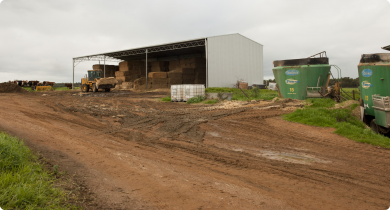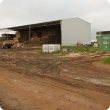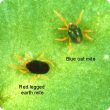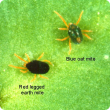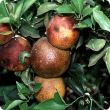Mites & spiders
Mites
Mites are minute (usually less than 1mm) arachnids with eight legs when adults. They are often pests of animals and plants, infest stored food products and in some cases transmit diseases.
Mites are a risk for Western Australian primary producers as they impact upon market access and agricultural production.
WA is free from some of the world's major agricultural mite pests. Biosecurity and management measures on your property are vital in preventing the spread of mites.
The Department of Primary Industries and Regional Development provides:
- biosecurity/quarantine measures at the WA border to prevent the entry of mites
- advice on widespread mites present in the state.
For advice on mites search our website, the Western Australian Organism List or contact our Pest and Disease Information Service (PaDIS).
For diagnostic services, please contact our Diagnostic Laboratory Services.
Spiders
Spiders are eight legged arachnids. They are not agricultural pests and do not spread disease or damage crops or food products. Spiders can play a beneficial role by feeding on pest insects. There are hundreds of species of spiders in Australia, with very few spiders that are potentially harmful.
Contact the Western Australian Museum for further information on spiders or Poisons Information on 13 11 26 for treatment of severe bites.
Filter by search
Filter by topic
- Crops (13) Apply Crops filter
- Horticulture (8) Apply Horticulture filter
- Fruit (7) Apply Fruit filter
- Livestock & animals (3) Apply Livestock & animals filter
- Grains (3) Apply Grains filter
- Pome fruit (2) Apply Pome fruit filter
- Vegetables (2) Apply Vegetables filter
- Pest insects (2) Apply Pest insects filter
- Stone fruit (2) Apply Stone fruit filter
- Livestock management (2) Apply Livestock management filter
- Grapes & wine (2) Apply Grapes & wine filter
- Citrus (2) Apply Citrus filter
- Nursery & cutflowers (1) Apply Nursery & cutflowers filter
- Nematodes (1) Apply Nematodes filter
- Mechanical, physical and cultural (1) Apply Mechanical, physical and cultural filter
- Pest animals (1) Apply Pest animals filter
- Potatoes (1) Apply Potatoes filter
- Livestock species (1) Apply Livestock species filter
- Strawberries (1) Apply Strawberries filter
- Pulses (1) Apply Pulses filter
- Plant biosecurity (1) Apply Plant biosecurity filter
- Biosecurity (1) Apply Biosecurity filter
- Bees (1) Apply Bees filter
- Bananas (1) Apply Bananas filter
- Avocados (1) Apply Avocados filter
- Biosecurity & quarantine (1) Apply Biosecurity & quarantine filter
- Canola (1) Apply Canola filter
- Field peas (1) Apply Field peas filter
- Feeding & nutrition (1) Apply Feeding & nutrition filter
- Control methods (1) Apply Control methods filter
- Livestock research & development (1) Apply Livestock research & development filter

